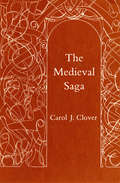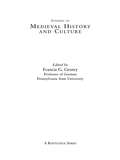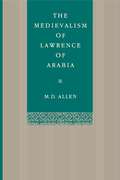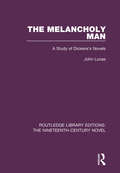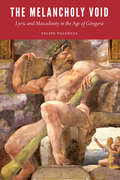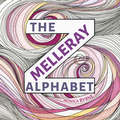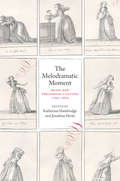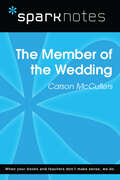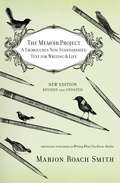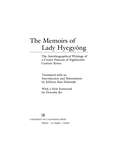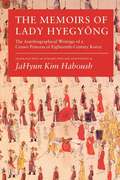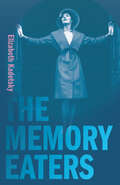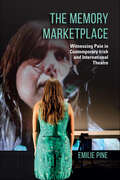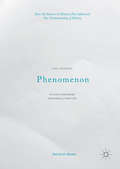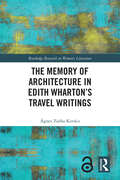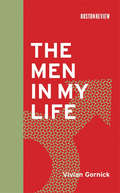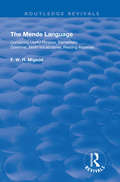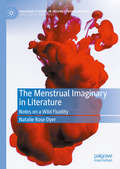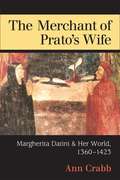- Table View
- List View
The Medieval Python: The Purposive and Provocative Work of Terry Jones (The New Middle Ages)
by R. F. Yeager Toshiyuki TakamiyaThis is a collection of essays by diverse hands engaging, interrogating, and honoring the medieval scholarship of Terry Jones. Jones' life-long engagement with the Middle Ages in general, and with the work of Chaucer in particular, has significantly influenced contemporary understanding of the period generally, and Middle English letters in particular. Both in film of all types - full-feature comedy (Monty Python and the Holy Grail) as well as educational television series for BBC, the History Channel, etc. (e.g., Medieval Lives) - and in his published scholarship (e.g., Chaucer's Knight, in original and revised editions, Who Murdered Chaucer?), Jones has applied his unique combination of carefully researched scholarship, keen intelligence, fearless skepticism of establishment thinking, and his broad good humor to challenge, enlighten and reform. No one working today in either Middle English studies or in period-related film and/or documentary can proceed untouched by Jones' purposive, provocative views. Jones, perhaps more than any other medievalist, can be said to be an integral part of what Palgrave deems the "common dialogue."
The Medieval Saga
by Carol J. CloverWritten in the thirteenth century, the Icelandic prose sagas, chronicling the lives of kings and commoners, give a dramatic account of the first century after the settlement of Iceland—the period from about 930 to 1050. To some extent these elaborate tales are written versions of traditional sagas passed down by word of mouth. How did they become the long and polished literary works that are still read today?The evolution of the written sagas is commonly regarded as an anomalous phenomenon, distinct from contemporary developments in European literature. In this groundbreaking study, Carol J. Clover challenges this view and relates the rise of imaginative prose in Iceland directly to the rise of imaginative prose on the Continent. Analyzing the narrative structure and composition of the sagas and comparing them with other medieval works, Clover shows that the Icelandic authors, using Continental models, owe the prose form of their writings, as well as some basic narrative strategies, to Latin historiography and to French romance.
The Medieval Tradition of Thebes: History and Narrative in the Roman de Thebes, Boccaccio, Chaucer, and Lydgate (Studies in Medieval History and Culture)
by Dominique BattlesFirst Published in 2004. Routledge is an imprint of Taylor & Francis, an informa company.
The Medievalism of Lawrence of Arabia (G - Reference, Information and Interdisciplinary Subjects)
by Malcolm D. AllenM. D. Allen's study deals with T. E. Lawrence's lifelong interest in the medieval world, especially medieval literature, and its considerable influence on his view of himself and of the Arabs with whom he fought in an archaic theater of war, and hence his own literary production. The Medievalism of Lawrence of Arabia investigates the influence Lawrence's interest in medieval life and literature had on his attitudes toward life in general and—in content, theme, and diction—on his masterpiece, Seven Pillars of Wisdom, in particular. Allen begins with a brief biography of Lawrence—his early interest in things medieval and his somewhat controversial BA thesis on crusader castles. Allen then reveals the extent to which Lawrence's ideas about honor, warfare, and chivalry in the Arab war against the Turks were shaped by his reading in medieval writings such as Malory's Morte d'Arthur. (Both, as he makes clear, were warrior societies dominated by horses.) Lawrence's reading in the nineteenth-century medievalism is also explored, as in Tennyson's Idylls of the King, and Ruskin's writing on art, where the parallel between Ruskin's ideas on ornament and Lawrence's ideas about the dignity of war is demonstrated. Allen then identifies the medieval and neomedieval texts of Seven Pillars of Wisdom and shows why and to what effect Lawrence borrowed from chivalric, neochivalric, and pseudochivalric works, and sometimes transmogrified them, revealing Lawrence's greatest inspiration to be an English translation of the Moallakat (which is, so to speak, the Arabic Beowulf). Allen sheds new light on many aspects of the influence of medievalism on Lawrence's thought and writing.
The Melancholy Man: A Study of Dickens's Novels (Routledge Library Editions: The Nineteenth-Century Novel #25)
by John LucasFirst published in 1980, this book surveys Dickens’ growing power to drive deep into the causes of his contemporary conditions. It reveals the importance of nature to Dickens as a rich metaphor of human freedom and potentiality, and emphasises his concern with time and the problems of freedom. The author considers the peculiarity of Dickens being unanimously acclaimed as a great writer considering the difficulty in placing him definitively within the literary tradition. The author argues Dickens was an isolated figure, indifferent to changing fashions and with a strong sense of the dignity of human nature and that this formed the basis of his character and writings.
The Melancholy Void: Lyric and Masculinity in the Age of Góngora (New Hispanisms)
by Felipe ValenciaAt the turn of the seventeenth century, Spanish lyric underwent a notable development. Several Spanish poets reinvented lyric as a melancholy and masculinist discourse that sang of and perpetrated symbolic violence against the female beloved. This shift emerged in response to the rising prestige and commercial success of the epic and was enabled by the rich discourse on the link between melancholy and creativity in men. In The Melancholy Void Felipe Valencia examines this reconstruction of the lyric in key texts of Spanish poetry from 1580 to 1620. Through a study of canonical and influential texts, such as the major poems by Luis de Góngora and the epic of Alonso de Ercilla, but also lesser-known texts, such as the lyrics by Miguel de Cervantes, The Melancholy Void addresses four understudied problems in the scholarship of early modern Spanish poetry: the use of gender violence in love poetry as a way to construct the masculinity of the poetic speaker; the exploration in Spanish poetry of the link between melancholy and male creativity; the impact of epic on Spanish lyric; and the Spanish contribution to the fledgling theory of the lyric.The Melancholy Void brings poetry and lyric theory to the conversation in full force and develops a distinct argument about the integral role of gender violence in a prominent strand of early modern Spanish lyric that ran from Garcilaso to Góngora and beyond.
The Melleray Alphabet
by Monica ByrneAn Illuminated Alphabet.Monica Byrne's artfully crafted alphabet gives a whimsical nod to the illuminated manuscripts of ages past. This gorgeous book will take children on an art-filled journey from A to Z. With surprising entries in three languages, children will learn to see their letters--and the world around them--in a brand new light.
The Melodramatic Moment: Music and Theatrical Culture, 1790–1820
by Jonathan Hicks Katherine HambridgeWe seem to see melodrama everywhere we look—from the soliloquies of devastation in a Dickens novel to the abject monstrosity of Frankenstein’s creation, and from Louise Brooks’s exaggerated acting in Pandora’s Box to the vicissitudes endlessly reshaping the life of a brooding Don Draper. This anthology proposes to address the sometimes bewilderingly broad understandings of melodrama by insisting on the historical specificity of its genesis on the stage in late-eighteenth-century Europe. Melodrama emerged during this time in the metropolitan centers of London, Paris, Vienna, and Berlin through stage adaptations of classical subjects and gothic novels, and they became famous for their use of passionate expression and spectacular scenery. Yet, as contributors to this volume emphasize, early melodramas also placed sound at center stage, through their distinctive—and often disconcerting—alternations between speech and music. This book draws out the melo of melodrama, showing the crucial dimensions of sound and music for a genre that permeates our dramatic, literary, and cinematic sensibilities today. A richly interdisciplinary anthology, The Melodramatic Moment will open up new dialogues between musicology and literary and theater studies.
The Member of the Wedding (SparkNotes Literature Guide Series)
by SparkNotesThe Member of the Wedding (SparkNotes Literature Guide) by Carson McCullers Making the reading experience fun! Created by Harvard students for students everywhere, SparkNotes is a new breed of study guide: smarter, better, faster. Geared to what today's students need to know, SparkNotes provides: *Chapter-by-chapter analysis *Explanations of key themes, motifs, and symbols *A review quiz and essay topicsLively and accessible, these guides are perfect for late-night studying and writing papers
The Memoir Project: A Thoroughly Non-Standardized Text for Writing & Life
by Marion Roach SmithA recent study revealed that the Number 1 thing that baby boomers want to do in retirement is write a book....about themselves. It's not that every person has lived such a unique or dramatic life, but we inherently understand that writing memoir-whether it's a book, blog, or just a letter to a child-is the single greatest portal to self-examination. While there have been other writing books, there's been nothing like Marion Roach Smith's THE MEMOIR PROJECT. Marion has written four books and she's been teaching a sold-out memoir writing class for 13 years. Her new book is a disarmingly frank, but wildly fun, distillation of all the unsentimental lessons that WORK. Tired topics like writing exercises, morning pages and "writer's block" are replaced with quirky, provocative tactics that teach you to write with purpose. Previously self-published in April 2010 (under the title Writing What You Know: Realia), the book has already proven hugely popular, and with its new title and updated content, it is sure to find an even bigger and even more enthusiastic audience.
The Memoirs of Lady Hyegyong: The Autobiographical Writings of a Crown Princess of Eighteenth-century Korea
by Jahyun Kim Haboush Dorothy KoLady Hyegyong's memoirs, which recount the chilling murder of her husband by his father, form one of the best known and most popular classics of Korean literature. From 1795 until 1805 Lady Hyegyong composed this masterpiece, depicting a court life Shakepearean in its pathos, drama, and grandeur. Presented in its social, cultural, and historical contexts, this first complete English translation opens a door into a world teeming with conflicting passions, political intrigue, and the daily preoccupations of a deeply intelligent and articulate woman. <P> JaHyun Kim Haboush's accurate, fluid translation captures the intimate and expressive voice of this consummate storyteller. Reissued nearly twenty years after its initial publication with a new foreword by Dorothy Ko, The Memoirs of Lady Hyegyong is a unique exploration of Korean selfhood and an extraordinary example of autobiography in the premodern era.
The Memoirs of Lady Hyegyong: The Autobiographical Writings of a Crown Princess of Eighteenth-century Korea
by Jahyun Kim HaboushLady Hyegyong's memoirs, which recount the chilling murder of her husband by his father, is one of the best known and most popular classics of Korean literature. From 1795 until 1805 Lady Hyegyong composed this masterpiece, which depicts a court life whose drama and pathos is of Shakespearean proportions. Presented in its social, cultural, and historical contexts, this first complete English translation opens a door into a world teeming with conflicting passions, political intrigue, and the daily preoccupations of a deeply intelligent and articulate woman. JaHyun Kim Haboush's accurate, fluid translation captures the intimate and expressive voice of this consummate storyteller. The Memoirs of Lady Hyegyong is a unique exploration of Korean selfhood and of how the genre of autobiography fared in premodern times.
The Memory Eaters (Juniper Prize for Creative Nonfiction)
by Elizabeth KadetskyOn autopsy, the brain of an Alzheimer's patient can weigh as little as 30 percent of a healthy brain. The tissue grows porous. It is a sieve through which the past slips. As her mother loses her grasp on their shared history, Elizabeth Kadetsky sifts through boxes of the snapshots, newspaper clippings, pamphlets, and notebooks that remain, hoping to uncover the memories that her mother is actively losing as her dementia progresses. These remnants offer the false yet beguiling suggestion that the past is easy to reconstruct—easy to hold. At turns lyrical, poignant, and alluring, The Memory Eaters tells the story of a family's cyclical and intergenerational incidents of trauma, secret-keeping, and forgetting in the context of 1970s and 1980s New York City. Moving from her parents' divorce to her mother's career as a Seventh Avenue fashion model and from her sister's addiction and homelessness to her own experiences with therapy for post-traumatic stress disorder, Kadetsky takes readers on a spiraling trip through memory, consciousness fractured by addiction and dementia, and a compulsion for the past salved by nostalgia.
The Memory Marketplace: Witnessing Pain in Contemporary Irish and International Theatre (Irish Culture, Memory, Place)
by Emilie PineWhat happens when cultural memory becomes a commodity? Who owns the memory? In The Memory Marketplace, Emilie Pine explores how memory is performed both in Ireland and abroad by considering the significant body of contemporary Irish theatre that contends with its own culture and history. Analyzing examples from this realm of theatre, Pine focuses on the idea of witnesses, both as performers on stage and as members of the audience. Whose memories are observed in these transactions, and how and why do performances prioritize some memories over others? What does it mean to create, rehearse, perform, and purchase the theatricalization of memory? The Memory Marketplace shows this transaction to be particularly fraught in the theatricalization of traumatic moments of cultural upheaval, such as the child sexual abuse scandal in Ireland. In these performances, the role of empathy becomes key within the marketplace dynamic, and Pine argues that this empathy shapes the kinds of witnesses created. The complexities and nuances of this exchange—subject and witness, spectator and performer, consumer and commodified—provide a deeper understanding of the crucial role theatre plays in shaping public understanding of trauma, memory, and history.
The Memory Phenomenon in Contemporary Historical Writing
by Patrick H. HuttonIn this book, the author provides a comprehensive overview of the intense and sustained work on the relationship between collective memory and history, retracing the royal roads pioneering scholars have traveled in their research and writing on this topic: notably, the politics of commemoration (purposes and practices of public remembrance); the changing uses of memory worked by new technologies of communication (from the threshold of literacy to the digital age); the immobilizing effects of trauma upon memory (with particular attention to the remembered legacy of the Holocaust). He follows with an analysis of the implications of this scholarship for our thinking about history itself, with attention to such issues as the mnemonics of historical time, and the encounter between representation and experience in historical understanding. His book provides insight into the way interest in the concept of memory - as opposed to long-standing alternatives, such as myth, tradition, and heritage - has opened new vistas for scholarship not only in cultural history but also in shared ventures in memory studies in related fields in the humanities and social sciences.
The Memory of Architecture in Edith Wharton’s Travel Writings (Routledge Research in Women's Literature)
by Ágnes Zsófia KovácsEdith Wharton was not only the author of novels and short stories but also of drama, poetry, autobiography, interior decoration, and travel writing. This study focuses on Wharton’s symbolic representations of architecture in her travel writings. It shows how a network of allusions to travel writing and art history books influenced Wharton’s representations of architectural and natural spaces. The book demonstrates Wharton’s complex relationship to works of art historians (John Ruskin, Émile Mâle, Arthur C. Porter) and travel authors (Wolfgang Goethe, Henry Adams, Henry James) in the trajectory of her travel writing. Kovács surveys how the acknowledgment of Wharton’s sources sheds light both on the author’s model of aesthetic understanding and scenic architectural descriptions, and how the shock of the Great War changed Wharton’s travel destinations but not her symbolic view of architecture as a mediator of things past. Wharton’s symbolic representations of architecture provide a new key to her travel writings.
The Memory of Colonialism in Britain and France: The Sins of Silence (Cambridge Imperial and Post-Colonial Studies)
by Itay LotemThis book explores national attitudes to remembering colonialism in Britain and France. By comparing these two former colonial powers, the author tells two distinct stories about coming to terms with the legacies of colonialism, the role of silence and the breaking thereof. Examining memory through the stories of people who incited public conversation on colonialism: activists; politicians; journalists; and professional historians, this book argues that these actors mobilised the colonial past to make sense of national identity, race and belonging in the present. In focusing on memory as an ongoing, politicised public debate, the book examines the afterlife of colonial history as an element of political and social discourse that depends on actors’ goals and priorities. A thought-provoking and powerful read that explores the divisive legacies of colonialism through oral history, this book will appeal to those researching imperialism, collective memory and cultural identity.
The Men in My Life
by Vivian GornickVivian Gornick, one of our finest critics, tackled the theme of love and marriage in her last collection of essays, The End of the Novel of Love,a National Book Critics Circle Award finalist. In this new collection, she turns her attention to another large theme in literature: the struggle for the semblance of inner freedom. Great literature, she believes, is not the record of the achievement, but of the effort. Gornick, who emerged as a major writer during the second-wave feminist movement, came to realize that "ideology alone could not purge one of the pathological self-doubt that seemed every woman's bitter birthright." Or, as Anton Chekhov put it so memorably: "Others made me a slave, but I must squeeze the slave out of myself, drop by drop." Perhaps surprisingly, Gornick found particular inspiration for this challenge in the work of male writers--talented, but locked in perpetual rage, self-doubt, or social exile. From these men--who had infinitely more permission to do and be than women had ever known--she learned what it really meant to wrestle with demons. In the essays collected here, she explores the work of V. S. Naipaul, James Baldwin, George Gissing, Randall Jarrell, H. G. Wells, Loren Eiseley, Allen Ginsberg, Hayden Carruth, Saul Bellow, and Philip Roth. Throughout the book, Gornick is at her best: interpreting the intimate interrelationship of emotional damage, social history, and great literature. Praise for The End of the Novel of Love:"[Gornick] is fearless.... Reading her essays, one is reassured that the conversation between life and literature is mutually sustaining as well as mutually corrective." --Elizabeth Frank, New York Times Book Review "Reading [Gornick] is a thrilling, invigorating, challenging experience." --Barbara Fisher, Boston Sunday Globe "Vivian Gornick's prose is so penetrating that reading it can be almost painful.... [This book] stands out as a model of luminous clarity." --Susie Linfield, Los Angeles Times Praise for The Solitude of the Self:"I love writers who treat thinking as a dynamic process. Ms. Gornick does--here and in all her books. Imagine a photographer of the psyche. She studies her subject from all angles. Whether in close-up or on a landscape crowded with political and religious movements, she explores the public and private selves.... What a potent book this is!" --Margo Jefferson, New York Times A Boston Review Book
The Men in My Life (Boston Review Books)
by Vivian GornickGornick on V. S. Naipaul, James Baldwin, George Gissing, Randall Jarrell, H. G. Wells, Loren Eiseley, Allen Ginsberg, Hayden Carruth, Saul Bellow, and Philip Roth and the intimate relationship between emotional damage and great literature.Vivian Gornick, one of our finest critics, tackled the theme of love and marriage in her last collection of essays, The End of the Novel of Love, a National Book Critics Circle Award finalist. In this new collection, she turns her attention to another large theme in literature: the struggle for the semblance of inner freedom. Great literature, she believes, is not the record of the achievement, but of the effort.Gornick, who emerged as a major writer during the second-wave feminist movement, came to realize that “ideology alone could not purge one of the pathological self-doubt that seemed every woman's bitter birthright.” Or, as Anton Chekhov put it so memorably: “Others made me a slave, but I must squeeze the slave out of myself, drop by drop.” Perhaps surprisingly, Gornick found particular inspiration for this challenge in the work of male writers—talented, but locked in perpetual rage, self-doubt, or social exile. From these men—who had infinitely more permission to do and be than women had ever known—she learned what it really meant to wrestle with demons. In the essays collected here, she explores the work of V. S. Naipaul, James Baldwin, George Gissing, Randall Jarrell, H. G. Wells, Loren Eiseley, Allen Ginsberg, Hayden Carruth, Saul Bellow, and Philip Roth. Throughout the book, Gornick is at her best: interpreting the intimate interrelationship of emotional damage, social history, and great literature.
The Mende Language: Containing Useful Phrases, Elementary Grammar, Short Vocabularies, Reading Materials (Routledge Revivals)
by F.W.H. MigeodFirst published in 1908, this volume emerged in the midst of the British Protectorate of Sierra Leone. The author, F.W.H. Migeod, studied the Mende nation in eastern Sierra Leone and followed the example of the grammar (1882) and vocabulary (1884) published by Dr. Schoen in using the southern form of the Mende language. Beginning with an introduction to the recent history, culture and characteristics of the Mende nation and Sierra Leone, this volume covers useful phrases, grammar, vocabulary and example reading materials including stories and songs collected from native speakers.
The Menstrual Imaginary in Literature: Notes on a Wild Fluidity (Palgrave Studies in (Re)Presenting Gender)
by Natalie Rose DyerThis book draws on literary, cultural, and critical examples forming a menstrual imaginary—a body of work by women writers and poets that builds up a concept of women’s creativity in an effort to overturn menstrual prejudice. The text addresses key arbiters of the menstrual imaginary in a series of letters, including Sylvia Plath the initiator of ‘the blood jet’, Hélène Cixous the pioneer of a conceptual red ink and the volcanic unconscious, and Luce Irigaray the inaugurator of women’s artistic process relative to a vital flow of desire based in sexual difference. The text also undertakes provocative against-the-grain re-readings of the Medusa, the Sphinx, Little Red Riding Hood, and The Red Shoes, as a means of affirmatively and poetically re-imagining a woman’s flow. Natalie Rose Dyer argues for re-envisioning menstrual bleeding and creativity in reaction and resistance to ongoing and problematic societal views of menstruation.
The Merchant Of Prato's Wife: Margherita Datini And Her World, 1360-1423
by Ann Morton CrabbAlthough the fourteenth-century Italian merchant Francesco Datini has received attention from business historians, there has previously been no full study of his wife, Margherita Datini. Drawing on a sizable trove of Margherita's correspondence held in the Archivio di Stato di Prato, including hundreds of letters she exchanged with Francesco, Ann Crabb investigates the social and economic importance of women's roles as wives and mothers, early modern European views on honor, and the practice of letter writing in Margherita's world. Margherita's often colorful comments demonstrate her attitudes toward her rather unhappy marriage and her inability to have children, along with other aspects of her life. Her letters reveal the pride she felt in carrying out her many responsibilities as a wife and, later, a widow: in scribal letter writing, in business, in household management, and in farming. Crabb emphasizes that the role of a wife was a recognized social position, beyond her individual relations with her husband, and provided opportunities beyond what restrictive laws or restrictive views of female honor would suggest. Further, Crabb considers Margherita's successful efforts, on her own initiative and in her late thirties, to learn to read and write at a literate level. This book will be of interest to both scholars and general readers of women's history. In addition, historians of early modern Italy and, more generally, of early modern Europe will find this book valuable.
The Merchant of Havana: The Jew in the Cuban Abolitionist Archive
by Stephen SilversteinAs Cuba industrialized in the nineteenth century, an epochal realignment of the social order occurred. In this period of change, two seemingly disparate, yet nevertheless intertwined, ideological forces appeared: anti-Semitism and abolitionism. As the antislavery movement became organized in Cuba, the argument grew that Jews participated in the African slave trade and in New World slavery, and that this participation gave Jews extraordinary influence in the new Cuban economy and culture. What was remarkable about this anti-Semitism was the decidedly small Jewish population on the island in this era. This form of anti-Semitism, Silverstein reveals, sprang almost exclusively from mythological beliefs.
The Merchant of Havana: The Jew in the Cuban Abolitionist Archive
by Stephen SilversteinLAJSA Book Award Winner, 2017, Latin American Jewish Studies Association As Cuba industrialized in the nineteenth century, an epochal realignment of the social order occurred. In this period of change, two seemingly disparate, yet nevertheless intertwined, ideological forces appeared: anti-Semitism and abolitionism. As the antislavery movement became organized in Cuba, the argument grew that Jews participated in the African slave trade and in New World slavery, and that this participation gave Jews extraordinary influence in the new Cuban economy and culture. What was remarkable about this anti-Semitism was the decidedly small Jewish population on the island in this era. This form of anti-Semitism, Silverstein reveals, sprang almost exclusively from mythological beliefs.

